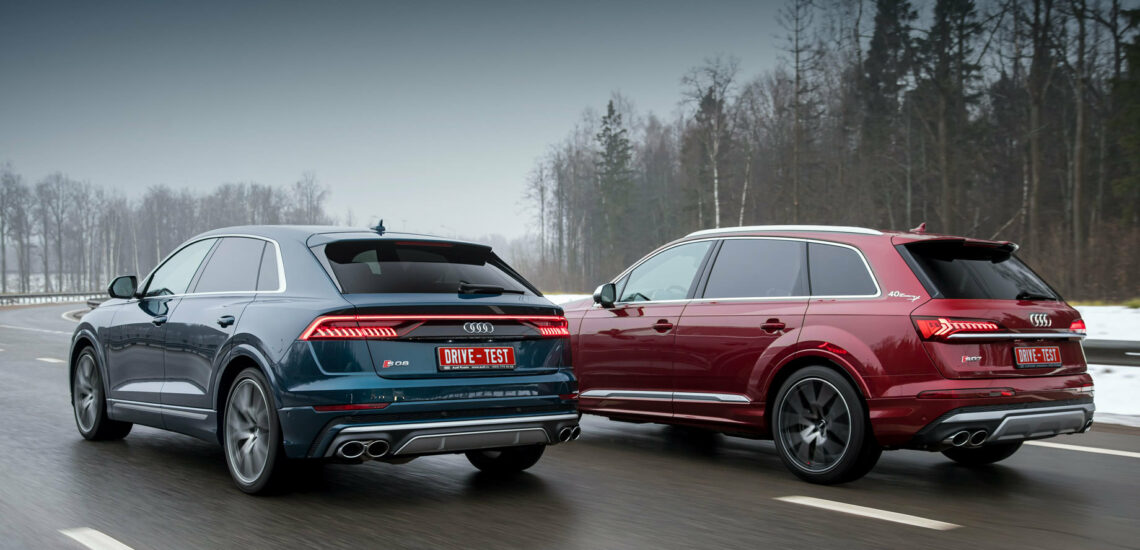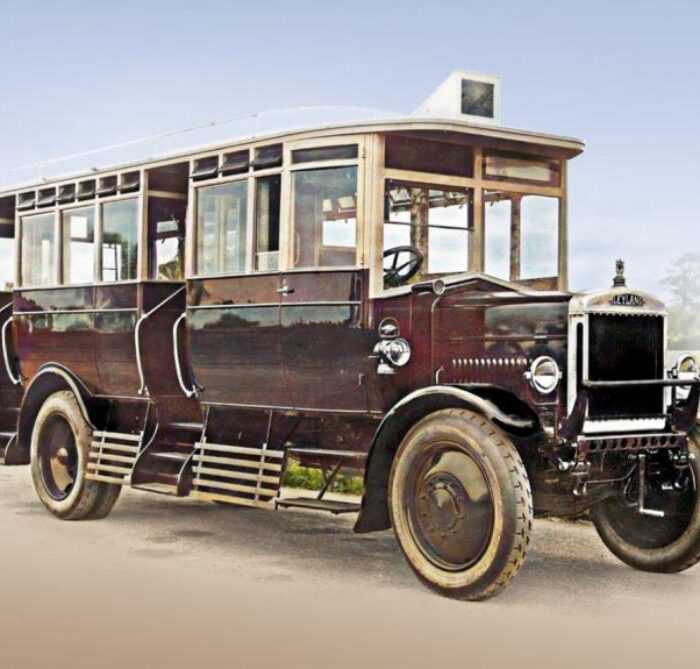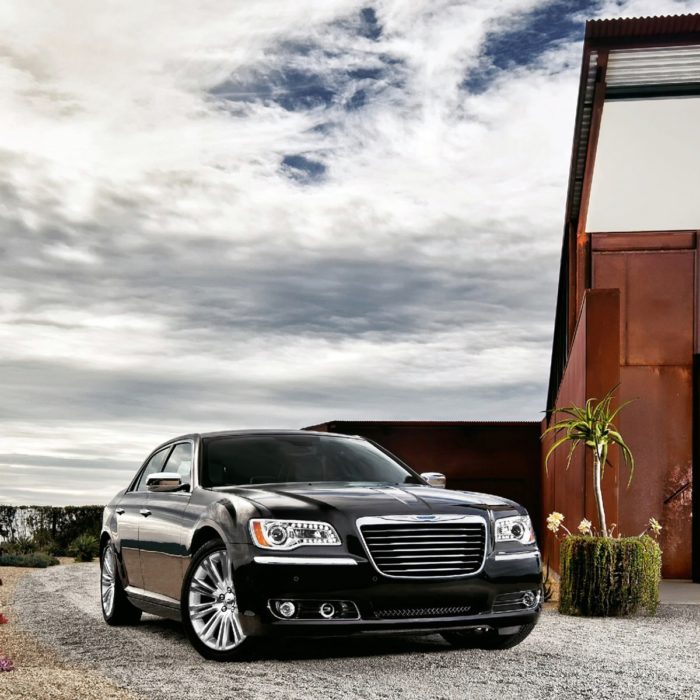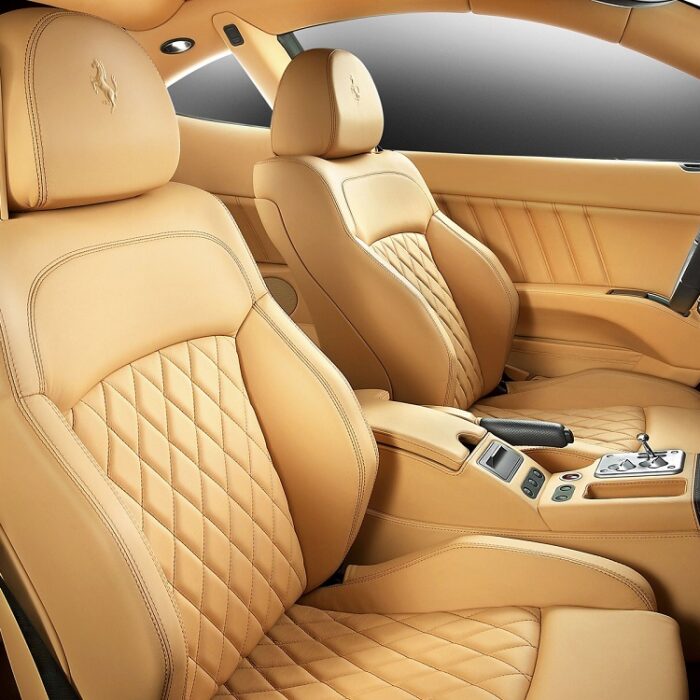We continue the conversation about high-power diesel crossovers, started by comparing the BMW X6 M50d and the Mercedes GLE Coupe 400 d. Instead of doing a single test of the SQ8 hatchback after them, I’ll also add the SQ7 station wagon — after all, it was the first to receive a unique-for-Europe V8 4.0 TDI engine. I wonder which of our participants is better suited for a super diesel engine, and does the SQ7 differ from the SQ8 on the go?
I have not yet seen the restyled Q7 with my own eyes. They messed up with the external decor, but if there is a version that comes with an updated grille and intricate optics, then this is the SQ7. The digital panels fit well into the sophisticated interior and, after getting to know the e-tron, even evoke pleasant associations. The virtual keys are large, and the touchscreen adjustable response helps reduce distractions. The workplace is geometrically flawless.
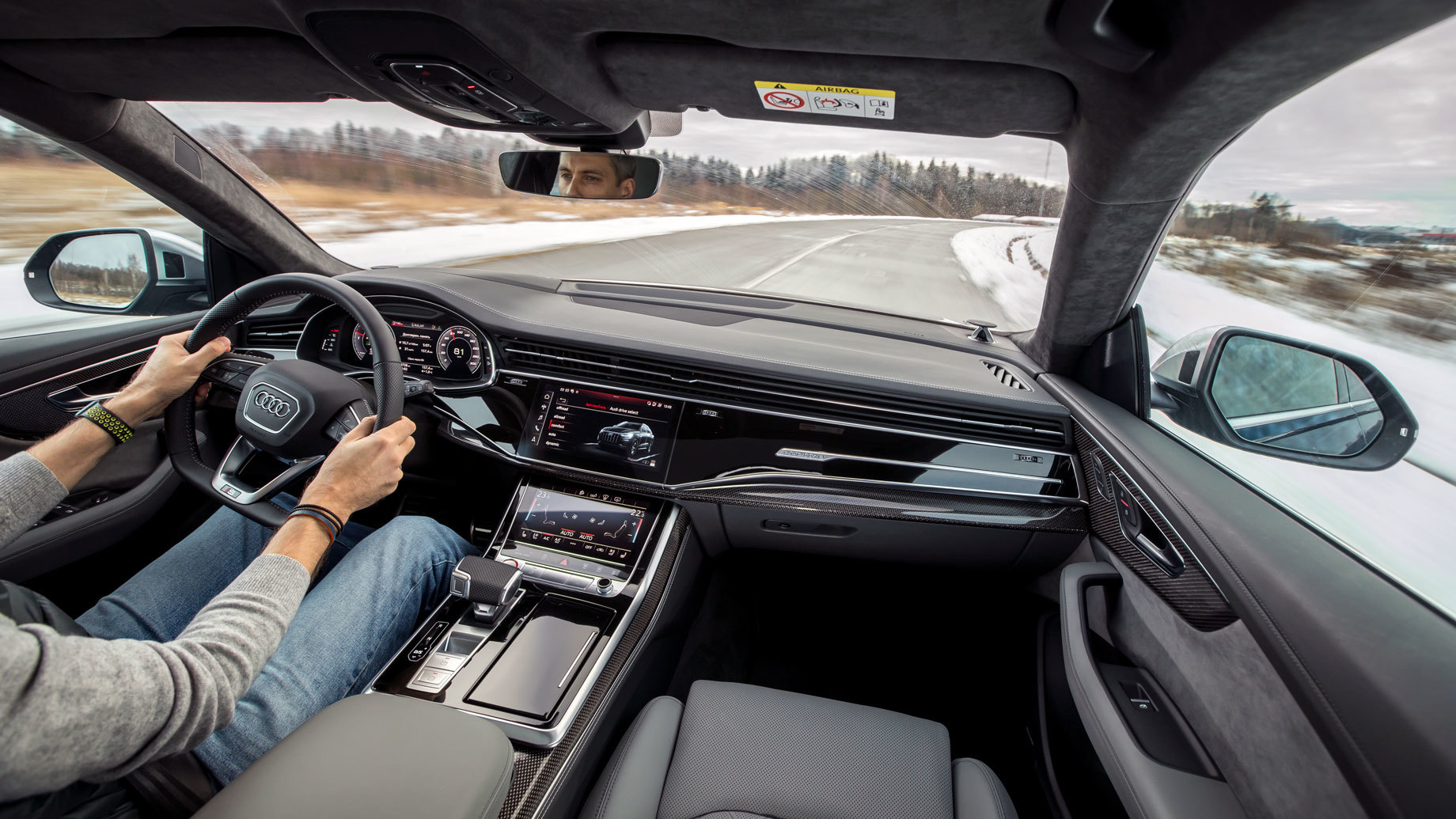
In the SQ8 it is almost the same, only the visibility is slightly worse. It can be seen, however, that the “eight” was created taking into account the experience of the “seven”. It has longer door handles that are neatly stamped for a keyless locking sensor instead of a cheap pushbutton notch. The central locking works silently, and doesn’t rattle like in the SQ7. In the rear doors there was a place for electric sun blinds. The backseat side-view is nicer.
The nozzles for supplying washer fluid are located on the wiper arms: the fluid is supplied directly to the brushes, while in the SQ7 it beats in three jets in the old fashioned way. The shape of the rear bumper has been optimized, its underside is hidden from prying eyes. Plastic shields have been added under the hood so that when topping up washer fluid in an inconveniently located reservoir, you are not afraid of the sight of carelessly sealed seams on the cross members.
At city speeds, you would never guess that there is a super diesel under the hood. If the X6 M50d wheezes expressively even at a cold start, then the V8 starts up quietly, like some ordinary three-liter six-cylinder engine. Half of the junction pipes are fake. The electric resonators under the bumper, which are not connected with the exhaust system, are responsible for the beautiful sound in the sport mode. By the way, in the SQ7 before restyling, their output channels were set into the main pipe, and the real exhaust twin-barrel stuck out.
Like the BMW, in the traffic jams at low pedal angles, the SQ8 constantly plays up. The digital tachometer shows that the automatic gearbox is awake: the speed either falls below a thousand, then jumps up to 1200… But it seems to be sleeping. Throttle response is sluggish. By limiting exhaust emissions, the SQ7 is constantly trying to accelerate within a single gear without allowing bursts. In Auto or Comfort modes, you need to push the accelerator deeply before Audi turns on the low gear. Dynamic stimulates the box, but the delays in the first phase of acceleration persist.
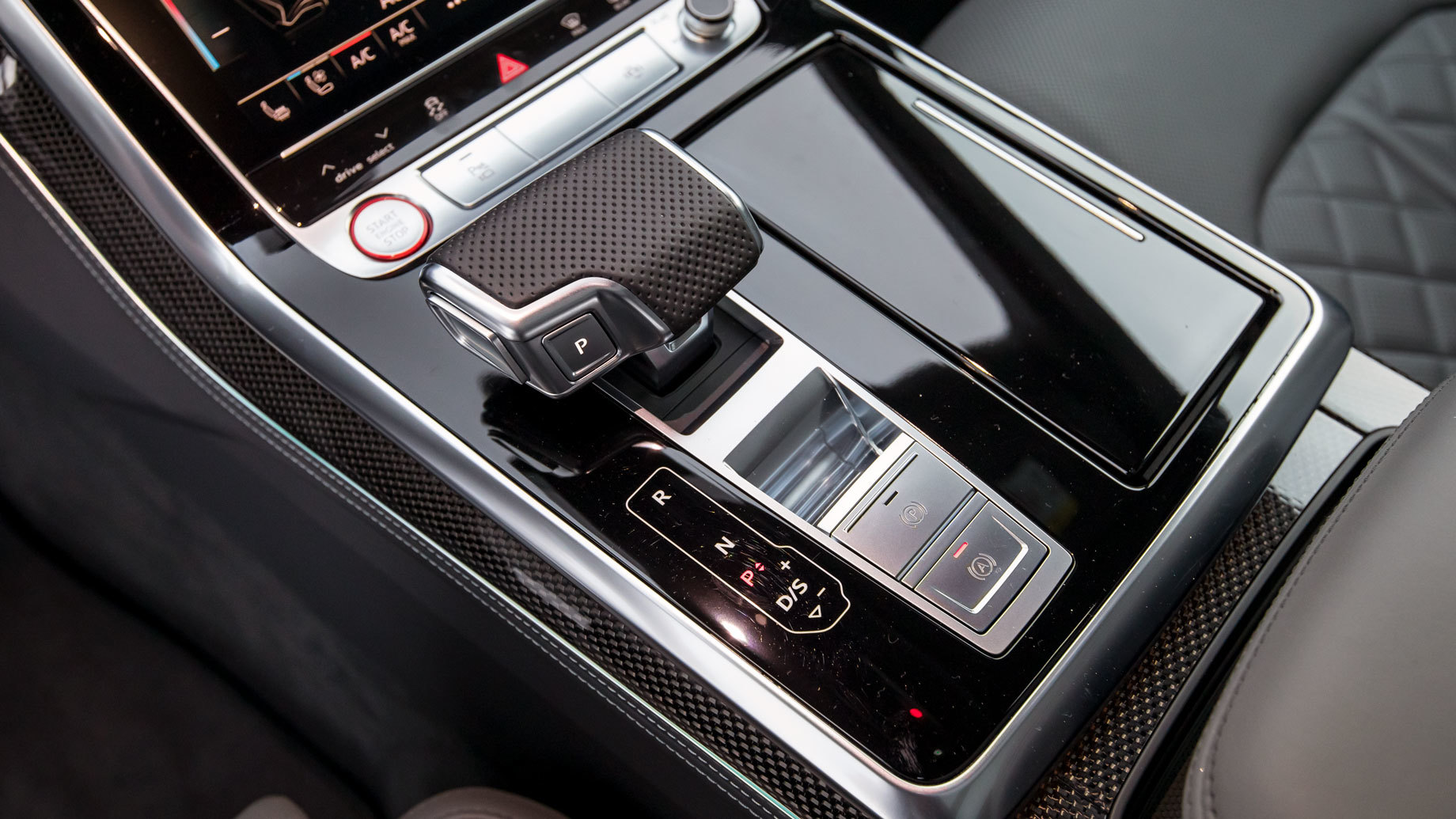
In theory, up to about 2000 rpm a super diesel does with one exhaust valve in each cylinder and the same turbocharger in most situations. This is how we drive in the city. Having driven the SQ7 and the six-cylinder version of the 45 TDI on the same street route, I don’t find a difference of 300 N•m and $ 44 505 between comparable car configurations.
Formally, the 4.0 engine develops peak 900 N•m from 1000 rpm. In practice, the SQ becomes itself, working off money, only after 2000-2500 rpm. The cams of the Audi Valvelift system take the right places on the camshafts, gas exchange starts in all 32 valves and the second turbine spins up.
The automatic gearbox picks up transition to biturbo with a soft jerk. Audi jumps up and follows the accelerator relentlessly. The throttle control program is hardly recognizable! The engine drags almost to the cutoff, leaving no harmful freedom of choice to the automatic gearbox. The gear shifting is logical, fast and smooth. The salon is filled with a low roar, and we are rushing… Alas, moments of great power are rare, and more often you are sitting in a turbo lag.
According to the superdiesel constructors’ idea, the combined supercharging, which the V8 4.0 TDI engine is famous for, should fight with it. In 2016, it was the first in the Audi lineup to get an additional electric compressor. At low revs, the 48-volt supercharger runs in parallel with the main turbocharger and turns off when the second one is engaged.
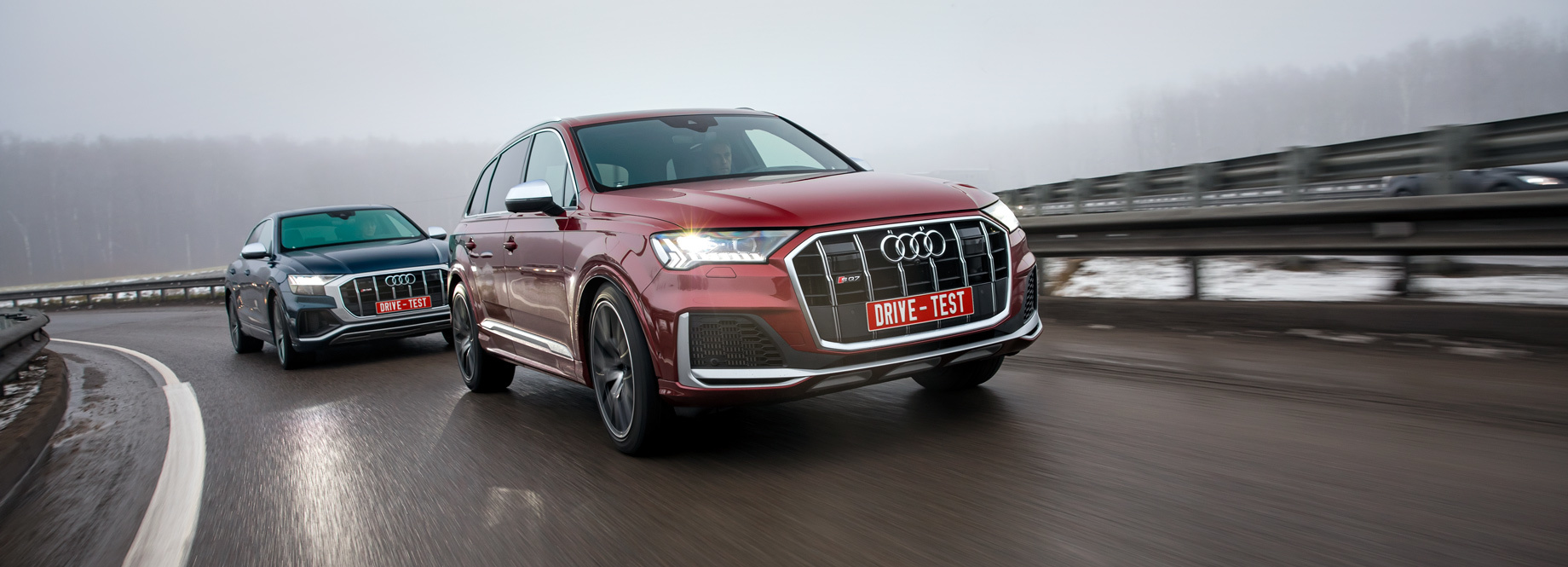
It is reminded that the four-liter engine should exist without electric supercharging. And it did: for more than a year it has been used in the European Tuareg. The Vehicle Type Approval (VTA) for the SQ7/SQ8 also indicates a different engine modification from the European (CZAC) with the CZAA index without mentioning an additional supercharger.
Its absence would explain the sluggish responses on the low-down. However, both the test car and, as it turns out, the customer’s ones have an electric compressor installed. It’s hard to explain why Audi is not selling what it was going to. But the main thing is that buyers don’t definitely complain, receiving more than promised. Alas, from the dynamics point of view, combined boost is nothing more than a gadget at low loads. Acceleration lacks linearity.
To relieve stress, there is a launch control: the start is given from 2500 rpm. Both Audis dart off, swerving on the cold pavement. At this point, their superiority over diesel competitors is undeniable. According to Racelogic, fully refueled cars with two passengers reach 60 miles/h half a second earlier than the M50d. If you just move your foot from the brake to the gas, you can put it down on the yellow light, and as the green one turns on, you just race off at the same time.
The brake drive gear is close to ideal everywhere: the pedal has no free play, the braking force progressively increases as the car slows down. However, even here there is a certain delay in reactions, this time due to the peculiarities of carbon ceramics. Composite rotors and pads require warming up in cold weather, and in rain and slush they need to be constantly dried. Forgetting this, you risk being in an awkward situation.
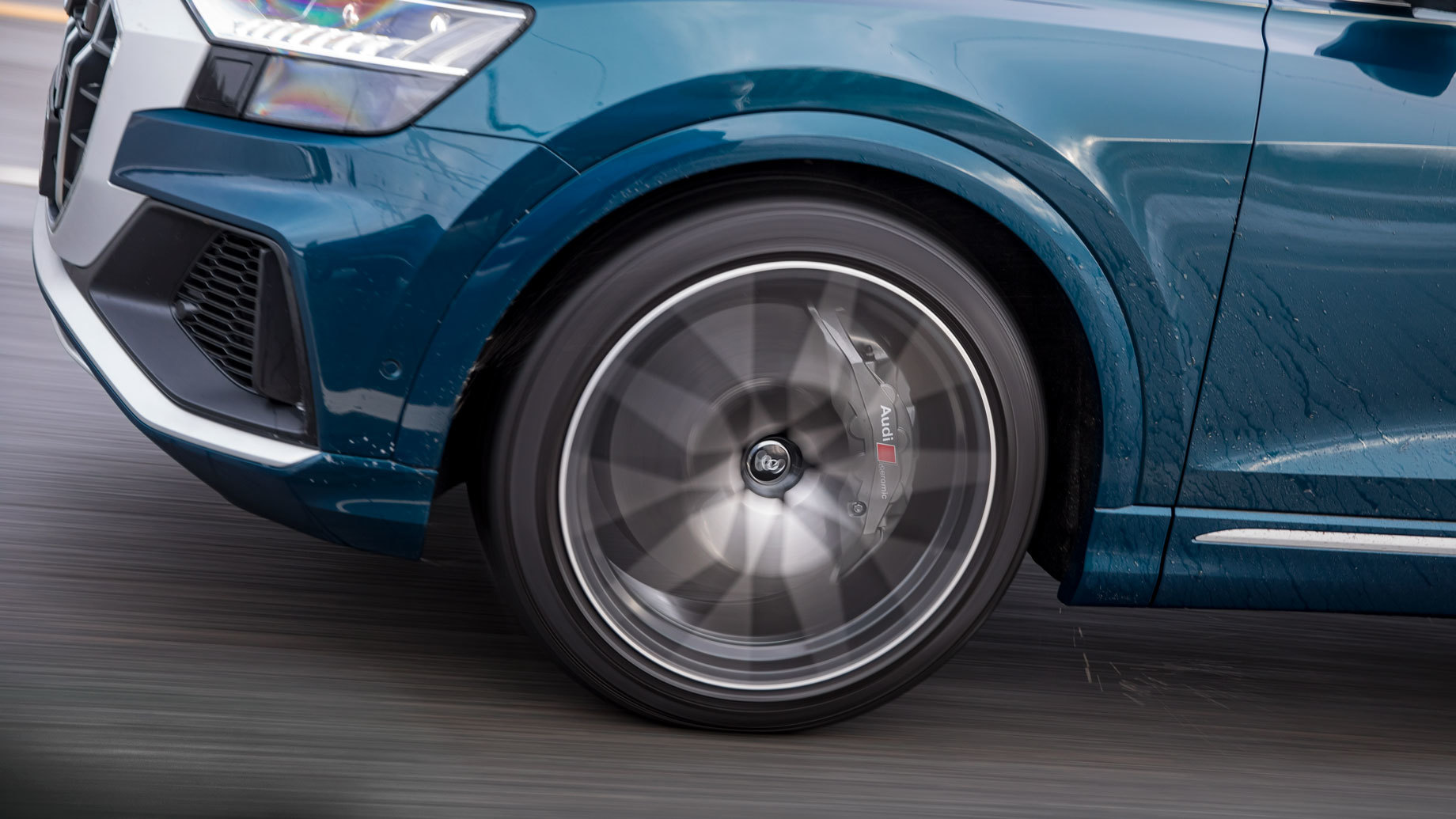
Even brakes with the inscription Audi ceramics are bad for mechanical action. Gravel is their worst enemy. I watched bloggers bathed the cherry SQ7 in the mud, but this is not a reason to repeat their nonsense. Since we were especially asked not to go off-road, then there is no need to risk the option for $12,000. (Both cars are equipped with ceramics, so the chances of ruining it are doubled.) We have already found out what permanent all-wheel drive with Thorsen is capable of, while comparing the regular Q8 with competitors.
Both Audis immediately respond to a grasping steering wheel. The steering mechanism is sharp, but ordinary: the unheated S-steering wheel needs 3.3 turns between the extreme positions. But both cars follow it quickly, almost without a roll, and so accurately find themselves in the intended destination, as if the trajectory is built by the car itself, and you only sign the route sheets.
I can not say that the handling of crossovers is exciting. But this is the first thing that represents Audi as an expensive car. Before you try the extreme dynamics, you notice the cold ease with which these crossovers change direction. You don’t feel like you’re driving a large, heavy car. Only from the back seat it is noticeable how little space the driver occupies in this huge cabin, enclosed by a cockpit corner. Over the wheel, even the SQ7 doesn’t feel huge. You don’t remember about the meters of the body behind your back. And if it were not for the hitch in the reactions to the fuel supply, the feeling of something full-sized would not have occurred at all.
The SQ8 has a more conspicuous force on the steering wheel, and it is too noticeable in a tense arc. If we are talking about delicate winter road pavements, then the information content of the drive gear suffers because of this. Even the default Auto mode is sportier than it should be. Not only is the steering wheel heavy, but the dense air suspension is harsh at the joints.
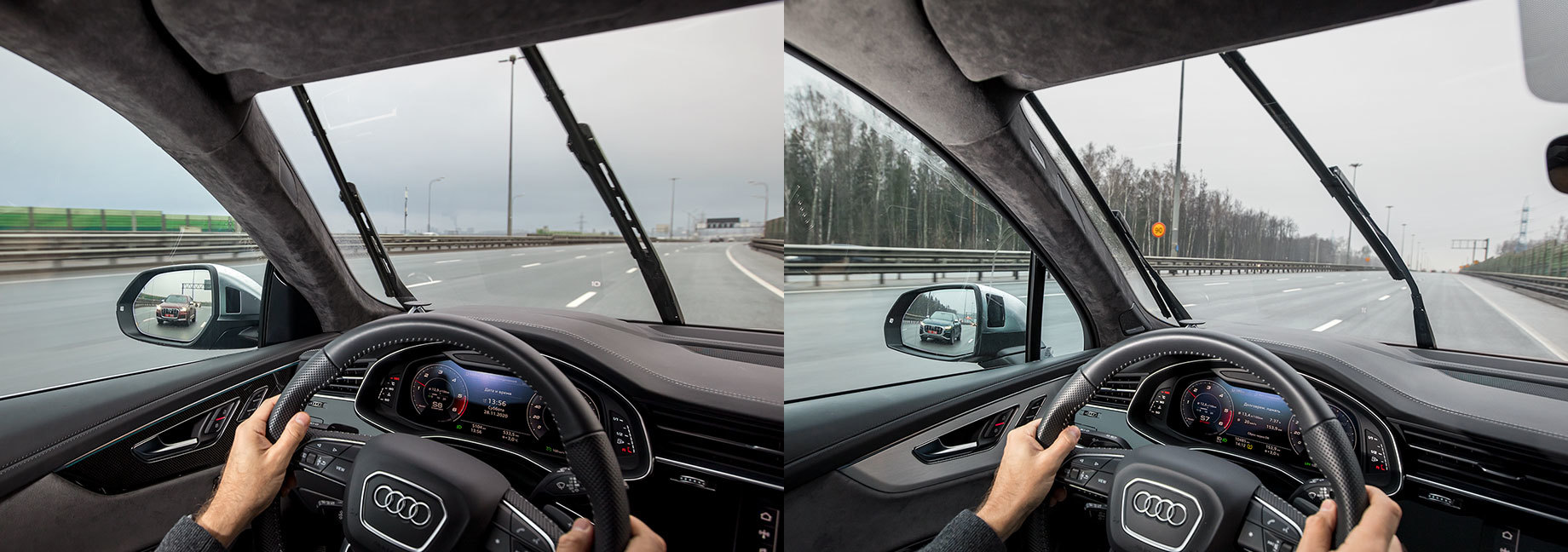
On the contrary, the SQ8 is more conducive to drive in Comfort mode, which provides the most sane damping in urban conditions: the microprofile is almost not felt, the shocks from the joints and the influence of the short wave are smoothed out. The sensitivity to transverse profile is lower, since stabilizers are loosened.
Dynamic is not for everyone. At the limit of the grip, you have to forcefully keep the steering wheel turned. There is no interconnection at this point. The tenacity of the SQ8 is unpleasant. When you are distracted by restoring force, it is difficult to catch the moment when the front wheels lose traction, which is important, because there is absolutely no means against the drift.
Both cars are equipped with a full package of mechatronics, including a rear steering gear and an active gearbox with overdrive planetary gears for each of the axle shafts. And if there are no questions at all to the 48-volt roll suppression system, then the full control manifests itself only at parking speeds. Moreover, the sport differential makes its presence felt only when you deliberately select a lower gear in a turning.
The SQ7 steering wheel is generally lighter, and does not turn to stone in Dynamics. It is much more pleasant to explore the limit here. With the best information content of the SQ7 mechanism, you can enjoy the benefits of a sports program. On the verge, the SQ7 does not give the impression of heavily overloaded wheels. Keeping an even gas, you can adjust the trajectory with the steering wheel. Subjectively, the load is spread over along the axes, and the more accurately you get into the revolutions, using the active differential, the stronger this feeling is.
When performing an emergency maneuver, the stabilization system blunts responses, but does not prevent either a detour or a return to your driving lane. Just lose a car control a little bit, and Audi falls into a skid at the first sharp change of lane, and a complete rearrangement requires precise work with the steering wheel in advance.
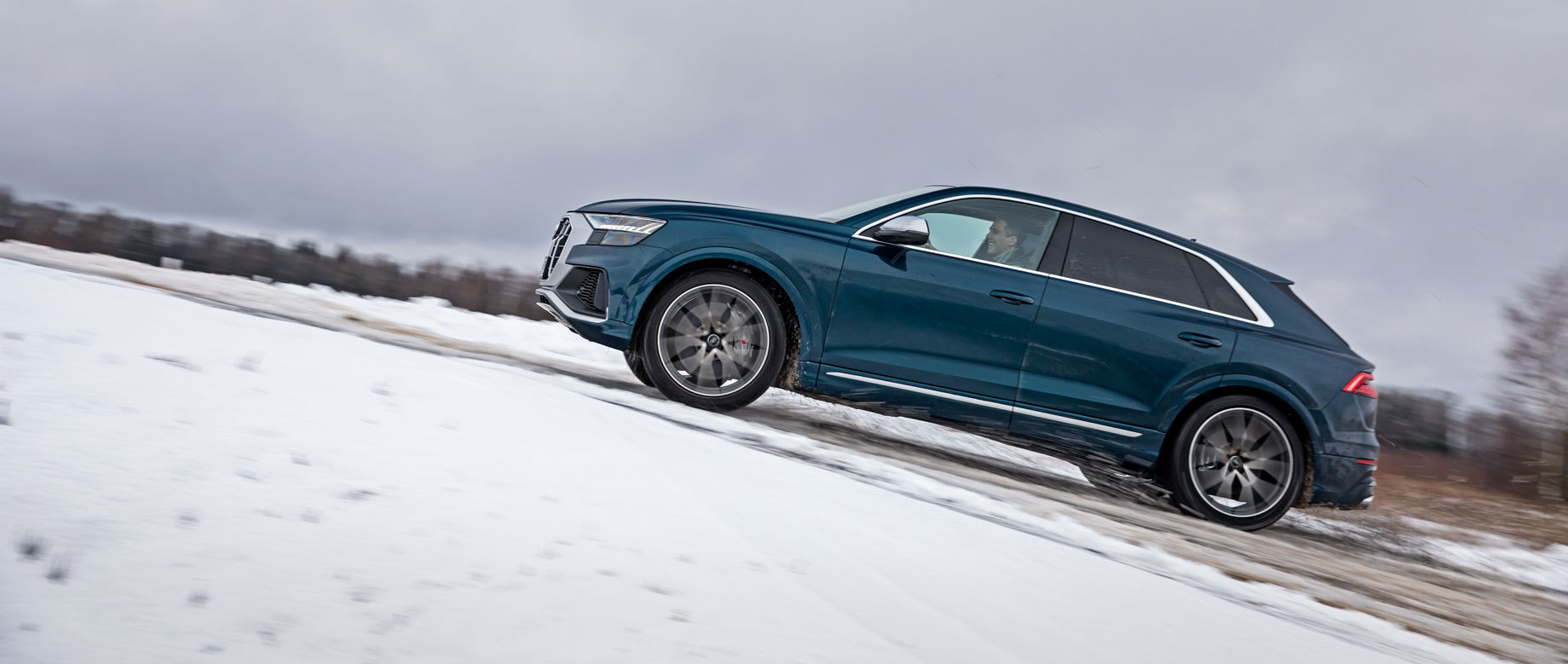
If not taken to extremes, skidding is no more than necessary to compensate for the tendency of a heavy car to slide out of a fast turn. If the SQ7 loses grip, it goes from drifting to a controlled slide with all four wheels before you get scared…
The basic wheels for the SQ7 are quite a divine size 285/45 R20. But on the test car the 22-inch wheels are installed. This is because the SQ8, created together with the Lamborghini Urus, sets new standards of beauty. It’s designed to be with 23 inches, so it can easily afford 22 with a 40 percent tire profile which is off the scale for the SQ7. They still do not like all sorts of patches, pits with sharp edges. But even Audi shakes are expensive.
The reserve of energy intensity is modest: the comfortable speed of overcoming speed bumps does not exceed 18 miles/h. But you can’t advise the owner of such a car to take smaller wheels, because even these seem not big enough in the arches of a massive body. And the tires should be chosen more carefully. Our Scorpion Winter makes noises not fitting its status, especially on abrasive pavement. Double windows do not save from this, and the constant rumble of Pirelli can be heard with a good decoupling of the cabin from aerodynamic noise and external sounds.
The maximum allowable dimension of SQ7 is 285/35 R22. And for air suspension, this is too much. It dampens the vibrations of large unsprung masses well, but it is difficult to withstand the peak loads created by low-profile tires at the junctions. Pokes from medium bumps are more noticeable. For the sake of experiment, we put wheels from SQ8 on the SQ7. Looks stately. But it is impossible to fully operate the car like that. Firstly, the offset is different, which affects the kinematics of the suspensions. Secondly, when Dynamic blows off the pneuma, it becomes roomless in the arches.
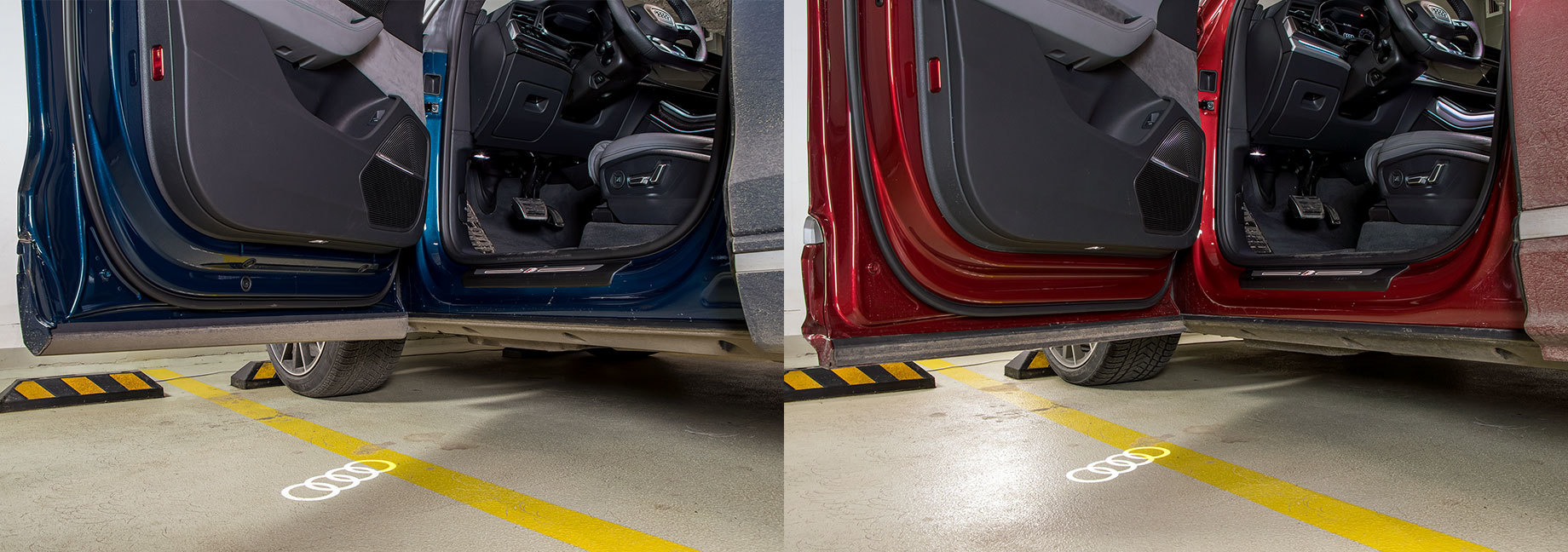
Even in “Comfort” the impression is ambiguous. The peaks of vertical acceleration are smoothed out better, but it is felt that the wheels are heavier. It becomes noticeable how a more pliant body dissipates part of the vibration load, but tends to make resonant noise. The SQ7 generally seems less organized. However, you need to give a pass on mileage. Judging by the condition of the interior and the car body, six thousand of journalistic miles were harsh. The paint is tired out by car wash, the chrome is covered with unusual spots, although the car has hardly dealt with winter.
However, if I choose between our crossovers, I would choose to go with the SQ7 as a fan of pure function. You can’t call the SQ8 impractical: the trunk is huge, the backseat is even more comfortable. But for me, this is a design-marketing creation, and there is some kind of clamp in its heavy steering wheel and emphasized tight chassis settings. Not in the sense of excessive rigidity, but in the sense of inner lack of freedom. The station wagon is not just shaky and noisier, but it is more communications capable. You can’t call it alive either, but at least it’s less cold.
The competitors of Audi are opposed not only by five seconds to the 60 miles/h, but also by the complete absence of secrets from the owner. There is no versatility of character inherent in the X6 at all. Both SQs are always unambiguous, similar in all modes. They do not give discoveries, like Mercedes, for example, which secret of rigidity is revealed only at high speed. But giving props, they maintain a decent level of comfort with constant readiness. Their behavior is so balanced that adequacy at high speed and under pressure is taken for granted.
Their super strength is not of the sort used to move quickly through space. Diesel SQ-crossovers are carters. The high-torque V8 engine was not given to them for racing, but to attach something heavy to the optional towbar and go on a trip. Not surprisingly, all driver mechatronics are optional: it develops that part of the character that remains unclaimed. It is surprising that the developers did not separate the SQ8 and the SQ7 more. Despite the ostentatious sportiness of the steering gear settings, the power unit is still recognized in every response of the hatchback to the gas…
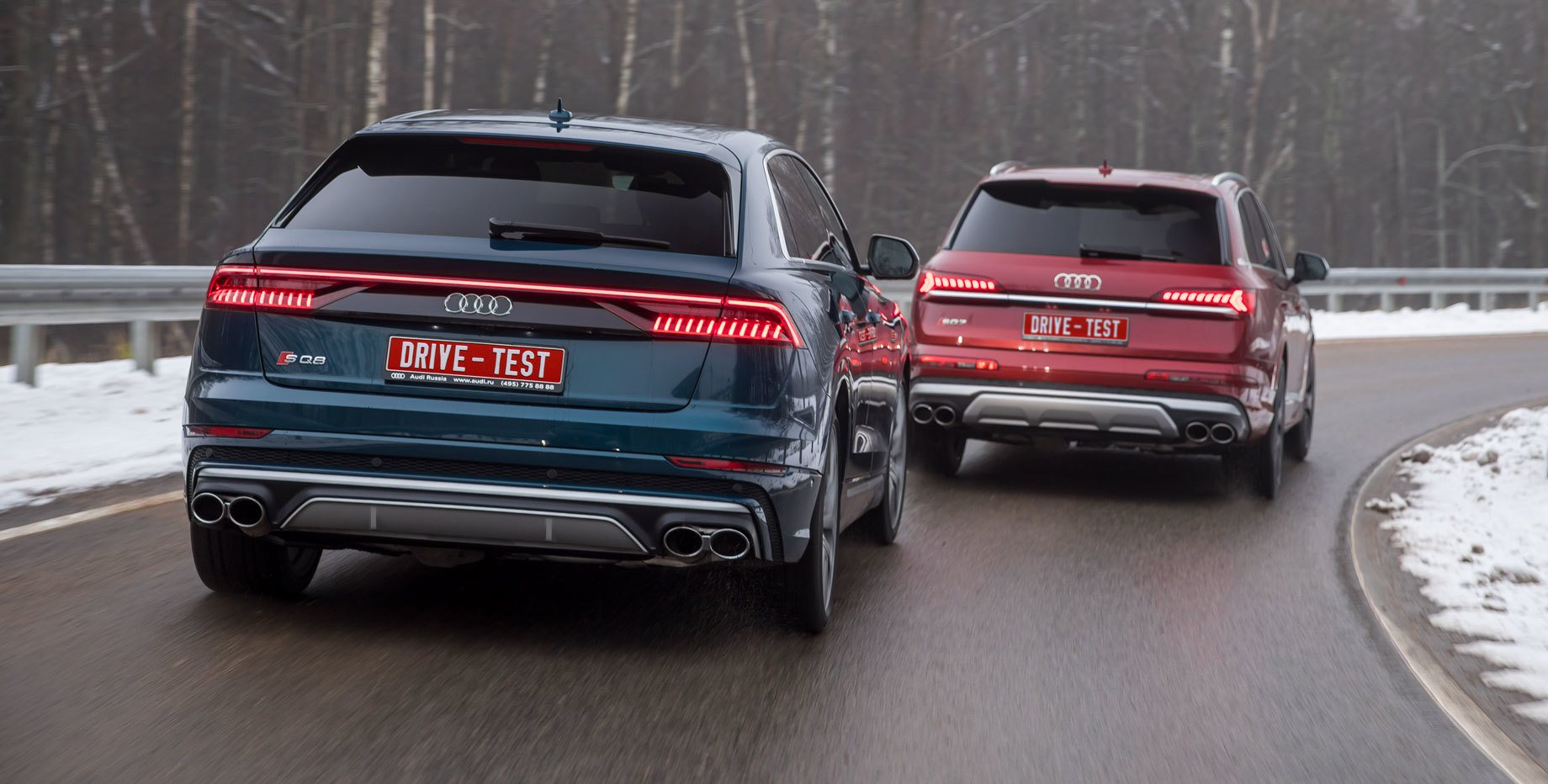
Perhaps, this is the last meeting with European V8 superdiesels, because almost all information about these cars has disappeared from the European press site, the technical data has been archived, only general words remain. Like, there was a case, but everything is in the past. The line of SQ crossovers in the main markets has already been updated: this engine has been replaced by the petrol “eight” Porsche of the same volume of 4.0 liters. It is not so quick and develops “only” 700 N•m, but it is more powerful: 507 hp are enough to reduce the declared acceleration time from 4.8 seconds to 4.1. The top Touareg has become exclusively hybrid. The eight-cylinder Range Rovers are about to sink into oblivion.
A whole era has been over. Subsequently, each car with a similar engine invariably made a strong impression. Even these well-trained and economically strangled Audis are no exception. There is something special about heavy cars with big diesels, like all of them are relatives.
This is a translation. You can read the original here: https://www.drive.ru/test-drive/audi/5fd0de1aec05c4333b000037.html

Published June 30, 2022 • 12m to read

